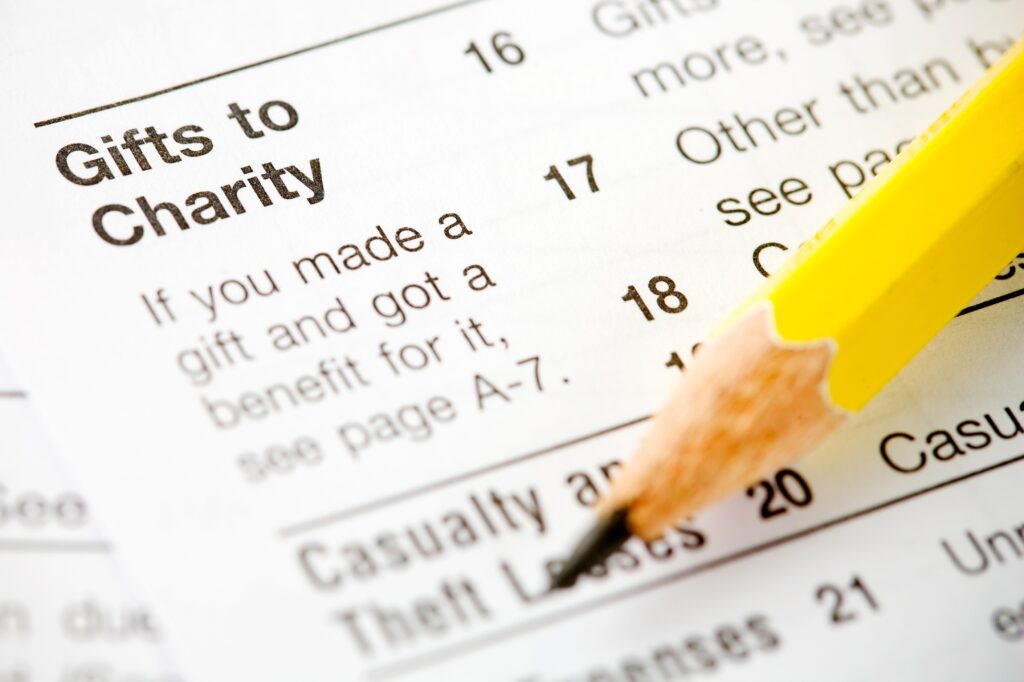As April 15th (the annual D-Day for U.S. taxpayers) is rapidly approaching, confusion still exists as to how to properly substantiate a donation or charitable contribution to a qualifying tax-exempt organization. The lack of clarity relates mostly to a seemingly endless series of technical changes to the substantiation requirements by the Internal Revenue Service.
Obtaining an income tax deduction for a charitable contribution requires that taxpayers meet strict rules for substantiating the donation. The rules vary depending on size of the donation, whether it is made in cash or as a non-cash contribution and, of course, whether the receiving organization qualifies for tax deductible contributions.
Cash Contributions
Cash contributions, perhaps the simplest and most common scenario, cannot be deducted for income tax purposes unless the taxpayer maintains a record of the contribution. The term, “record,” encompasses a bank record or written corroboration from the done organization. Interpretive regulations issued by the Treasury department and the Internal Revenue Service provide that a “bank record” includes a statement from a financial institution, an electronic funds transfer receipt, a cancelled check, a scanned image of both sides of a cancelled check obtained from a bank’s website, or a credit card statement. The regulations include an email confirmation as sufficient written communication.
Importantly, though it is a common practice, the provision of a blank pledge card received from the donee organization that is completed by the donor/taxpayer is not sufficient substantiation for cash contributions.
Contributions of $250 or more must be substantiated by a contemporaneous written acknowledgement proved by the donee organization. This written acknowledgement must include the following information to meet the Internal Revenue Service rules:
- The done organization’s name
- The date of receipt of the contribution
- The amount of any cash that the donor/taxpayer paid
- A description of any in kind “property contribution made by the donor/taxpayer
- A statement from the donee organization noting whether the donor/taxpayer received any goods or services in exchange for the contribution
- A description of any goods and services provided in exchange for the donor/taxpayer contribution and a good faith estimate of the value of those goods or services
- Finally, if the donee organization provided any intangible religious benefits, the written acknowledgement must include a description
By requiring the written confirmation to be “contemporaneous,” the regulations require that it be provided on, or before, the earlier of the date on which the donor/taxpayer files an income tax return for the year in which the contribution was made or the due date (including extensions) of the income tax return.
While most organizations receiving contributions are aware of these rules and generally adhere closely to them, it is important to realize that the Internal Revenue Service has the ability to take a very hard stand on strict compliance. In some cases, we have observed a total disallowance of a charitable contribution because the acknowledgement did not include a statement saying that the donor/taxpayer was provided no goods or services is consideration of the contribution. Similar conclusions can be found frequently in case law (see related post).
To mitigate this risk of examination and disallowance, taxpayers should simply review the written acknowledgement letters provided by those charitable organizations to whom they have contributed amounts in excess of $250 to verify that the “no goods or services were provided” language is included. Often, language not meeting this strict requirement (such as “your donation is deductible to the full extent of the law”) can be found in these written acknowledgements. Technically, this language is insufficient to substantiate the deduction.
It is critical that donors/taxpayers take responsibility for the required content of the written acknowledgement. Charitable organizations regularly experience changes in personnel and, often, such organizations are understaffed, in an attempt to guide precious resources to their exempt purpose. These circumstances can lead to oversight and the provision of written acknowledgements that are not technically in compliance with Internal Revenue Service guidance.
Donations of cash without a bank record or written substantiation are no longer able to be taken as a tax deduction. Examples that we often note are donors/taxpayers who make cash contributions to their churches on a weekly basis without either form of documentation.
Noncash Contributions
Substantiation is more complex for larger “in-kind” contributions. For noncash contributions with a value of $500, but less than $5,000, the donor/taxpayer must not only obtain a contemporaneous written acknowledgement, but must also file an additional tax form, Form 8283, Noncash Charitable Contributions, with their tax returns for the year in which the contribution is deducted.
An important, and significant, additional requirement applies to noncash contributions in excess of $5,000. Subject to certain exceptions, the donor/taxpayer making these contributions must obtain a qualified appraisal prior to filing the return for the year in which the contribution is deducted. Though this requirement affects few donor/taxpayers, the appraisal must be attached to the income tax return if the value is found to be $500,000 or more.
A failure to properly complete Form 8283 and include all of the required information and ancillary forms, would be found to technically not meet the substantiation requirements, thereby risking the loss of the entire deduction for the donated property.
Summary
While it is not difficult to meet the statutory requirements for substantiation of charitable contributions, it does require an element of care and effort to ensure that the donor’s/taxpayer’s charitable contributions are protected from challenge in the event of an Internal Revenue Service examination.
See https://www.irs.gov/charities-non-profits/substantiating-charitable-contributions or Publication 1771 for additional information about the substantiation rules.
It is important to keep these rules in mind as charitable giving occurs throughout each tax year. Attention to this important aspect of tax documentation and recordkeeping should be a constant financial focus when making such contributions.
For questions and comments, please contact Bob Grossman or Rick Dynoske at 412-338-9300.
Related Posts
Maximizing Noncash Charitable Contributions
Requirements for Charitable Contribution Deductions
IRS Backs off Controversial Alternative Charitable Contribution Substantiation Regulations






